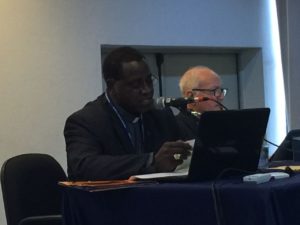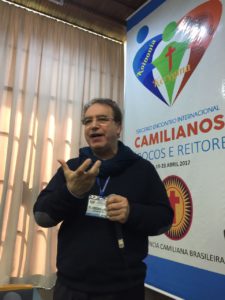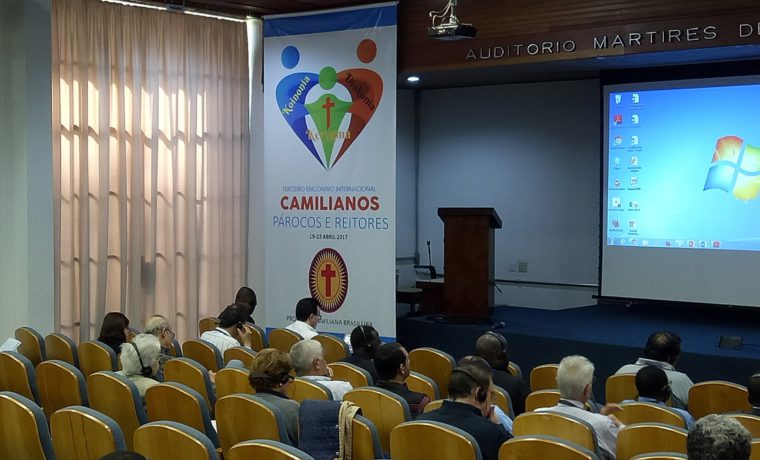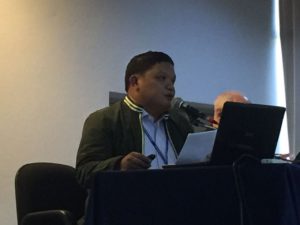Meeting of Camillian Parish Priests and Rectors Sao Paulo – BRAZIL – Day II – 20 April 2017
Camillian parishes: a place of communion (koinonia), of evangelization (kerygma), and mission (diakonia)
 On Thursday (April 20), the conference opens with a couple of reflections that offer suggestions on the Camillian identity of the parish ministry – Mons. Prosper Kontiebo, a Camillian Bishop of Tenkodogo, Burkina Faso, give his reflection on the parish as a place of communion, evangelization and mission and Fr. Gabriel Garcia, a Camillian parish priest of Makati, shares some of his experiences in managing parish pastoral program with a commitment to integrate in a more structured way pastoral health care and animation of service to the sick into the complex parish ministerial activity.
On Thursday (April 20), the conference opens with a couple of reflections that offer suggestions on the Camillian identity of the parish ministry – Mons. Prosper Kontiebo, a Camillian Bishop of Tenkodogo, Burkina Faso, give his reflection on the parish as a place of communion, evangelization and mission and Fr. Gabriel Garcia, a Camillian parish priest of Makati, shares some of his experiences in managing parish pastoral program with a commitment to integrate in a more structured way pastoral health care and animation of service to the sick into the complex parish ministerial activity.
Mons. Kontiebo proposes to offer his contribution to help the Camillian religious who have parochial or diocesan pastoral responsibilities to remain “Camillians” in their mission, that is, to fully live the charism in their diocesan or parish assignment, forming Christian communities – “Camillians” – that is, communities that live the spirit of Saint Camillus sensitive to the suffering people, to the most needy members, as St. Pope John Paul II emphasized. The activities carried out by the Camillian religious must have its specificity. Because, as Pope Francis says, the shepherd must emanate the smell of his sheep, and the sheep must emanate also the smell of their shepherd. Beginning with the tension between the Camillian vocation and parochial pastoral commitment, we will try to show that managing a parish or a sanctuary by a Camillian religious is not a deformation of his vocation, but another way of living the Camillian charism.
The reflection begins with this question that is often addressed to us by the people. How can a Camillian religious who has vowed to serve the sick even at risk of life, become an assistant parish priest or rector of a sanctuary and then a pastor and much more a bishop without betraying his vocation, his mission? How can you be a Camillian and parish priest? Is not a deformation or a vocational deviation? Does managing a parish or sanctuary really correspond to the Camillian charism? These questions should prompt us as Camillian religious who live this ministry to reflect in order to evaluate how, as a pastor, do you fully live the Camillian charism? How to be and remain Camillian in the administration of a parish or sanctuary? How does the pastoral assignment help the Camillian religious spread the charism to benefit not only the sick, but also the people who have been entrusted to him?
The ministry is the venue of expression of the charism, the place where the charism takes shape. The Camillian Order consecrates its activity to the poorest and the abandoned. (Const.51). Thus, the Camillian charism and ministry are two distinct but inseparable realities. The charism is stable (a gift of God) while ministry is conditioned by time and space, that is, it follows the ever changing conditions of time. The ministry allows us to develop the richness of the charism. The fact that the parish is based on a territory, to a precise community of faithful, he assumes his pastoral responsibility of shepherding to all who live in that territory. The parish is seen as a community that incarnates in time and space, the universal church. It is a church that lives in the middle of the houses of his children, Saint John Paul II said.
The pastoral responsibility of a pastor has a theological foundation, a responsibility that is actually connected to the three persons of the Holy Trinity. The Shepherd – God the Father. Here I will look after my own flock and takes care of it. I myself will search for my sheep and examine them. As a shepherd examines his flock while he himself is among his scattered sheep, so will I examine my sheep. (Eze 34: 11-12; Is 40, 11). The Prophet – God the Son, the Word. In times past, God spoke in partial and various ways to our ancestors through the prophets; in these last days, he spoke to us through a son, whom he made heir of all things and through whom he created the universe.” (Heb. 1, 1-2). The Sanctifier – God the Holy Spirit. “God chose you as the firstfruits* for salvation through sanctification by the Spirit and belief in truth.” (2Th 2,13; 1Pet 1,2). In the realization of his pastoral assignment, the pastor and his collaborators must actualize to their parishioners what the Trinity is for them. “[…] proclaiming the word of God (kerygma-martyria), celebrating the sacraments (leitourgia), and exercising the ministry of charity (diakonia). These duties presuppose each other and are inseparable.” (DCE 25).
How can we live and actualize the Camillian charism; actualizing the pastoral responsibility in a parish, or actualizing what the Trinity proposes to the people (sanctify, exercise, teach) as priest, prophet and king? Attention to the sick is an integral part of Jesus’ mission which he entrusted to His church, thus, to all baptized. “As you go, make this proclamation: The kingdom of heaven is at hand. Cure the sick, raise the dead, cleanse lepers, drive out demons. Without cost you have received; without cost you are to give.” (Mt 10: 7-8, Lk 10: 9).
By entrusting to the community of believers the care of the sick as an inseparable mission of evangelization, Jesus makes it clear that care for the sick is a constitutive element of pastoral care. In fact, the first Christian community immediately took care of the sick, and after Pentecost, the evangelical scenes that had been produced by the Master, (Acts 3,2-10; 5,12-16), had been repeated by the apostles. With fidelity, Christian communities should be exhorted (if not the case) to get close to the sick in imitation of the good Samaritan (Lk 10).
In the exercise of the parish pastoral responsibility, the Camillian religious must be interpreters of the Holy Trinity to their people, deploying great generosity bearing their own charism, the love towards the sick who are the center of their lives and of their actions. The parish community is an authentic continuation of the mission of Christ, if he will give his attention and service to the sick of the community.
How could this concern be manifested? We can indicate three paths: know, form, act.
To know: The pastor, his associates and all the faithful must know the general health situation and in particular the situation of the sick in his parish territory: health facilities, common illnesses, major health problems, big questions during the period of illness, and the identification of the needs of the sick.
To form: To develop periodical reflection on the topics of health, suffering, life and death during the pastoral year; To educate in discovering the salvific value of suffering and illness; to introduce into the organization of pastoral care, the pastoral module of health; To raise awareness of the parish community about health issues; To form a parish community that accompanies and supports people during illness and death; To open the pastoral health ministry to the parish community.
To act: To visit the sick according to the parish program; to facilitate access to the sacraments for the sick; to pray for the sick; to organize the days for the sick; to create and encourage the birth of Camillian inspired movements and associations; to create care centers for the elderly, terminally ill patients, for victims of disasters, for chronic patients; to encourage and value the lay or virginal consecration to the service to the sick; to organize signs of solidarity to those suffering.
The renewal of ministry allows us to better understand and explore the richness of the charism. Being a Camillian and a parish priest or rector is a ministry where the Camillian charism can be manifested. With this ministry, the Camillian offers his specific contribution (his charism) to church pastoral minsitry by forming typically Camillian communities. FULL TEXT HERE
Fr. Gabriel Garcia, a parish priest of Makati of the parish of Our Lady of Peace, shares some of his experiences in managing parish pastoral program with a commitment to integrate in a more structured way pastoral health care and animation of service to the sick into the complex parish ministerial activity. The parish should be primarily a place of communion in a Camillian way, an experience of proclamation and charity according to a ministry well-integrated into the vision and mission of the local church, in harmony with the diocesan bishop.
Communion in the parish life should find its utmost expression in the proclamation of the Word of God, growth in the grace of the sacraments, in the development of programs of hospitality and solidarity. According to the experience of Filipino culture and spirituality, Fr. Gabriel observes that the parish must be a communion of communities – one heart, one family, and a deep sharing in solidarity. Only in these terms will it be possible to make the parish a genuine ‘open hospital’, that is, an open space in which there is familiarity and empathy with the real and daily life of the people.
For the Camillian shepherds, this calls an authentic conversion. We are not owners of the parish pastoral program, but we must grow in a shared responsibility with the laity, towards the gift of the Word, the sacraments, fraternity, solidarity and charity. With this operative and decisive style, the shepherd will carry with him the odor of the sheep, and the sheep will also enjoy the reassuring presence of the odor of his pastor.
The different linguistic groups have reflected and shared some of their wishes and challenges of the Camillian ministry in the parish.
To be a religious-camillian-parish priests means to keep their charismatic identity in a transparent way. It would be very significant that the entire Camillian community could guarantee fraternal presence in synergy with the parish priest’s coordination. It would be an implicit witnessing of communion and shared charity: the entire Camillian community should take on parish engagement, overcoming the mentality of personal delegation reserved only to the parish priest.
The parish should be a place of social cohesion, involving principally lay people by offering them evangelization and formation. The parish, a family of families, requires a systematic ‘exodus’ to the families themselves, to the youth and the sick in need of listening, encouragement and assurance of hope.
A great challenge and opportunity is the laity formation, the growth of mutual appreciation and trust, in their real involvement using their skills and sensibilities to the work of formation, planning, and caring the sick. Only in these terms that communion will be simple but effective. The testimony of service and solidarity will be more immediate and the attraction will be very strong.
The ministry specifically Camillian – visiting the sick in hospital and family, proclaiming the gospel of salvation and hope to the suffering, offering the grace of the sacraments – should be not be taken as an addition to the classical and ordinary pastoral program of the parish, but should be integrated in every dimension of the parish pastoral ministry.
The parish ministry lived by a Camillian should be lived as an opportunity for animation and vocation promotion, to make known the spirituality and the person of Saint Camillus.
Another challenge is to ensure ministerial continuity between a pastor and his successor: a failure in this aspect are likely to create tensions in the life of the parish community. FULL TEXT HERE
 In the afternoon, Fr. Vincenzo Capozza and his two lay collaborators of the Sicilian-Neapolitan province, present an experience of a “Camillian parish mission”, a new model of witnessing the merciful love of Jesus Christ. It is an instrument that makes the transition from a pastoral of simple conversation to a pastoral missionary – going forth. Is a tool for revitalizing the ordinary course of parish life, which is often at risk of becoming infatuated. The Camillian parish mission work in the territory, in synergy with the pastors, with their collaborators, to stimulate a renewed sensitivity towards the most fragile and weak members of the same Christian community. The goal is not to replace the pastor or increase his burden of pastoral commitments, but to raise awareness of his person, his pastoral care to the same community towards the pastoral health and humanization of health. Through an intense work of preparation, the whole parish community is on a mission. It is a moment of involving young people, families, and other members of the parish community who are formed and sensible to the theme of pain and suffering through sharing of their personal experiences, the celebration of the sacraments of healing and hope. It is a form of ministry of patient consolation and growth for the whole community.
In the afternoon, Fr. Vincenzo Capozza and his two lay collaborators of the Sicilian-Neapolitan province, present an experience of a “Camillian parish mission”, a new model of witnessing the merciful love of Jesus Christ. It is an instrument that makes the transition from a pastoral of simple conversation to a pastoral missionary – going forth. Is a tool for revitalizing the ordinary course of parish life, which is often at risk of becoming infatuated. The Camillian parish mission work in the territory, in synergy with the pastors, with their collaborators, to stimulate a renewed sensitivity towards the most fragile and weak members of the same Christian community. The goal is not to replace the pastor or increase his burden of pastoral commitments, but to raise awareness of his person, his pastoral care to the same community towards the pastoral health and humanization of health. Through an intense work of preparation, the whole parish community is on a mission. It is a moment of involving young people, families, and other members of the parish community who are formed and sensible to the theme of pain and suffering through sharing of their personal experiences, the celebration of the sacraments of healing and hope. It is a form of ministry of patient consolation and growth for the whole community.
Next, is a quick presentation of the Camillian parish ministry of the respective provinces of the Order where the participants are coming from. There was a “kaleidoscope” of initiatives, pastoral creativity, sensitivity towards the sick, involvement of the laity, problems … with a common denominator as defined by the Camillian charism.
















Camillians on Facebook
Camillians on Twitter
Camillians on Instagram